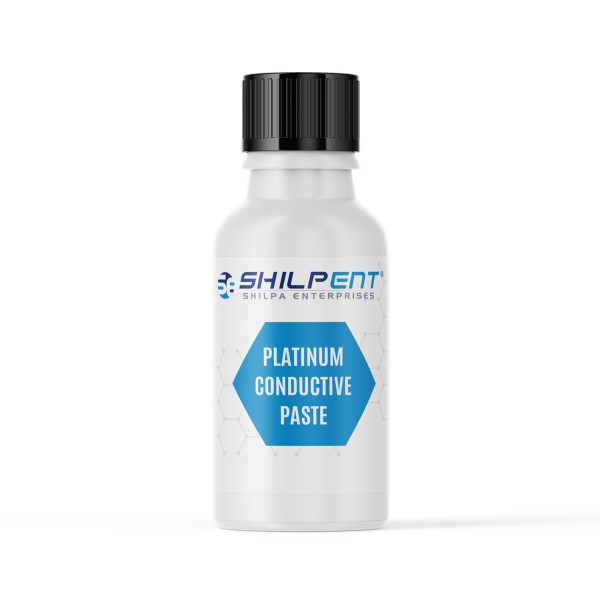
Graphene Oxide
Details and Specifications of Graphene Oxide Graphene Oxide Powder (GO) is a formulation of graphite being treated with oxidizers. The chemical bondage of carbon, oxygen, and hydrogen in ratios...



The Platinum Conductive Paste or Paint shares the same base components as the Silver Conductive Paint, except for the metal solids. While the processing is similar, the sintering of metal particles is anticipated to occur at significantly higher temperatures than in the case of silver. Additionally, the sublimation of the metal in a vacuum will occur at higher temperatures than in the case of silver.
Platinum Conductive Paste is a specialized mixture comprising finely divided platinum particles and a binder. It is utilized in a screen-printing method to create a thin, uniform layer of platinum on a substrate. Once the paste is applied, it is subjected to high-temperature firing to sinter the particles together. This results in the formation of a highly electrolytically active material.
Key specifications about the platinum paste:
Although this material's cost parameter is comparatively high, its exceptional performance, unique catalytic properties, high melting point, and conductivity make it worthwhile. It is suitable for various applications, such as electrochromic, fuel, and solar cells.
Solvents are crucial in conductive paste formations by managing viscosity and drying rates. It is essential to add additives like surfactants and dispersants to enhance the durability of the paste. This helps in the retardation of the Cohesion of platinum particles.
The platinum on the counter-electrode in dye solar cells enhances the cell’s effectiveness. It facilitates the movement of electrons from the electrolyte to the cell. This versatile paste also improves the efficiency of varied substrates such as metal, wood, ceramics, and glass. It is an ideal option for beginners as well as experienced artists, as it offers convenience and compatibility with various tools.
Researchers and scientists typically use platinum paste as a tool in material science and nanotechnology research. Its accurate deposition and conductivity characteristics make it worthwhile for prototyping and experimentation.
With the advancement of technology, platinum conductive paste may find applications in emerging fields. This includes the Internet of Things (IoT), wearable devices, and quantum computing, where materials with exceptional electrical properties are needed.
PT1 Platinum Conductive Paste is a multifunctional product suitable for multiple uses. It is well-suited for areas that need a see-through coating with outstanding electrocatalytic performance. The company manufactures fuel cells, sensors, catalysts, and electrodes, enabling advanced technologies and maximizing the potential of electrocatalysis.
PT1's oil-based formulation allows for effortless screen-printing uses. This results in films that exhibit exceptional consistency, replicability, and effectiveness. Hence, it is an excellent choice for the pilot production of DSSCs. When dried and fired at 420°C or higher, platinum nanoclusters disperse and form throughout a material. These nanoclusters can catalyze reactions effectively and maintain transparency, making them useful for electrochemical reduction processes.
To utilize Platinum Paste, adhere to the following instructions:
We are a trusted manufacturer and supplier of Platinum Conductive Paste. We have served this industry for the past ten years and adhere to all the safety guidelines and quality control criteria. We aim to provide exceptional quality products at a competitive price. From employing the finest raw materials to manufacturing premium-grade products, we deliver customized solutions and technical support depending on the requirements. With the expansion of new-age technology, our product feed ensures durability, consistency, and reproducibility for the best possible outcomes. Connect with us today to experience unmatched excellence with our Platinum Paste.
7 other products in the same category:
Details and Specifications of Graphene Oxide Graphene Oxide Powder (GO) is a formulation of graphite being treated with oxidizers. The chemical bondage of carbon, oxygen, and hydrogen in ratios...
Details and Specifications of High Pressure Needle Valve From global oil production to aerospace, High Pressure Needle Valve are essential in many industries. They are present in almost all...
Details and Specifications of High Pressure Non Return Valve The High Pressure Non Return Valve controls the flow of fluids or gases in systems under high-pressure. It is also known as Check Valve....
Details and Specifications of Quartz Cuvette A quartz cuvette is a tiny, transparent, rectangular container with various dimensions, materials, and quality requirements. It is a clear, transparent...
Description and Specifications of Silicon Wafers Silicon wafers (also referred to as substrates) are thin, disc-shaped slices. It is made from crystalline silicon. It has unique electrical...
Description and Specifications of Quartz Cuvette A Quartz Cuvette is a specialized laboratory instrument used in various scientific applications, particularly spectroscopy. It is a small,...
Description and Specifications of High Pressure Regulator A High Pressure Regulator controls gas and fluid pressure in industrial systems. It takes high pressure from one end and reduces it to a...